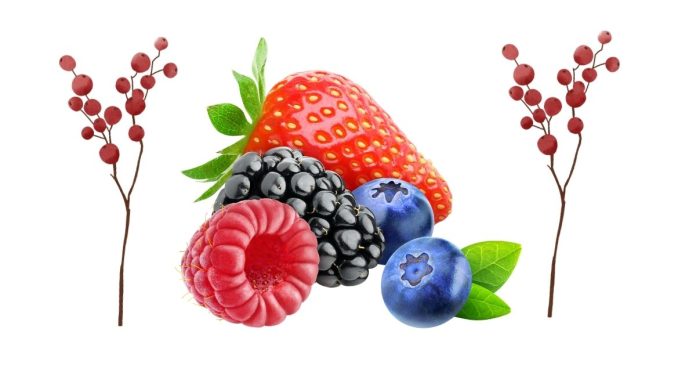Berries are among the most versatile and nutrient-rich fruits in the world. Known for their vibrant colors, sweet and tart flavors, and powerful health benefits, they can be enjoyed fresh, frozen, dried, or as part of your favorite recipes. But with so many varieties available, how do you tell your blueberries from your elderberries?
This guide dives into the wonderful world of berries, exploring their types, benefits, and unique characteristics.
1. What Are Berries?
Botanically speaking, a true berry is a fruit produced from the ovary of a single flower with seeds embedded in the flesh. However, in culinary terms, berries are small, juicy fruits that can be eaten whole. This means that fruits like strawberries and raspberries are berries in the culinary sense but not in the botanical sense.
2. Common Types of Edible Berries
Here’s a breakdown of some popular berries you might encounter:
A. Blueberries
- Description: Small, round, and blue to deep purple in color.
- Taste: Sweet with a mild tartness.
- Health Benefits:
- High in antioxidants, particularly anthocyanins.
- Boost brain health and may improve memory.
- Support heart health by reducing cholesterol levels.
- Best Uses: Add them to oatmeal, smoothies, pancakes, or eat them fresh as a snack.
B. Strawberries
- Description: Bright red with tiny seeds on the surface and a green leafy cap.
- Taste: Sweet and slightly tangy.
- Health Benefits:
- Rich in vitamin C and manganese.
- Promote skin health and reduce inflammation.
- Improve blood sugar control.
- Best Uses: Great in desserts, salads, or dipped in chocolate.
C. Raspberries
- Description: Delicate, red or black, with a hollow center.
- Taste: Sweet and tart.
- Health Benefits:
- High in fiber, aiding digestion.
- Contain ellagic acid, which may protect against cancer.
- Support heart health by reducing oxidative stress.
- Best Uses: Use them in jams, smoothies, or yogurt parfaits.
D. Blackberries
- Description: Large, dark purple to black clusters of drupelets.
- Taste: Sweet with an earthy undertone.
- Health Benefits:
- Packed with vitamins C and K.
- Support bone health and reduce inflammation.
- May improve oral health.
- Best Uses: Perfect for pies, cobblers, or as a fresh topping for ice cream.
E. Cranberries
- Description: Small, round, and bright red.
- Taste: Tart and slightly bitter when raw.
- Health Benefits:
- Help prevent urinary tract infections (UTIs).
- Rich in antioxidants that support immune health.
- Improve gut health by promoting beneficial bacteria.
- Best Uses: Used in sauces, juices, and dried as snacks or toppings.
F. Gooseberries
- Description: Round, translucent, and range from green to red.
- Taste: Tart when unripe, sweet when fully ripe.
- Health Benefits:
- High in vitamin C and dietary fiber.
- Aid in digestion and boost immunity.
- Support healthy skin and vision.
- Best Uses: Great in jams, chutneys, or eaten raw.
3. Exotic and Lesser-Known Berries
A. Acai Berries
- Description: Small, dark purple berries native to the Amazon rainforest.
- Taste: Earthy with hints of chocolate and berries.
- Health Benefits:
- High in antioxidants, especially anthocyanins.
- Boost energy and support heart health.
- Promote healthy skin and digestion.
- Best Uses: Commonly found in smoothie bowls or juices.
B. Elderberries
- Description: Small, dark purple to black berries that grow in clusters.
- Taste: Tart and slightly bitter when raw.
- Health Benefits:
- Boost the immune system and combat colds and flu.
- High in vitamin C and dietary fiber.
- Contain flavonoids with anti-inflammatory properties.
- Best Uses: Often made into syrups, jams, or teas.
C. Mulberries
- Description: Resemble elongated blackberries and come in red, black, and white varieties.
- Taste: Sweet with a hint of tartness.
- Health Benefits:
- High in iron and vitamin C.
- Support blood sugar regulation.
- Promote healthy liver function.
- Best Uses: Enjoy fresh, dried, or as a filling for pies.
D. Goji Berries
- Description: Small, red, and slightly chewy when dried.
- Taste: Sweet with a slightly bitter aftertaste.
- Health Benefits:
- Rich in vitamins A and C.
- Boost energy and immune function.
- Promote eye health due to their high levels of zeaxanthin.
- Best Uses: Add to trail mixes, teas, or sprinkle on salads.
4. Tips for Selecting and Storing Berries
- Choose Wisely: Look for firm, plump berries with vibrant colors. Avoid those with mold or bruises.
- Wash Before Eating: Rinse under cold water just before consuming to maintain freshness.
- Storage: Store fresh berries in the refrigerator and consume them within a few days. For long-term storage, freeze them on a tray before transferring to a bag.
5. Health Benefits of Eating Berries
Berries are nutrient powerhouses, offering:
- Rich Antioxidants: Protect against free radicals and reduce aging signs.
- High Fiber Content: Promote gut health and regulate blood sugar.
- Low Calories, High Nutrients: Perfect for weight management while delivering essential vitamins and minerals.
- Disease Prevention: May lower the risk of heart disease, cancer, and cognitive decline.
6. Fun Facts About Berries
- Strawberries aren’t true berries: Botanically, bananas are true berries, while strawberries are considered aggregate fruits.
- Blueberries were called “star berries”: The crown at the berry’s top resembles a star.
- Goji berries are also called “wolfberries”: They’ve been used in traditional Chinese medicine for centuries.
Conclusion
Berries are more than just tasty snacks; they’re a superfood packed with nutrients and flavor. Whether you’re enjoying a classic like strawberries or exploring exotic options like acai, there’s a berry for every palate. So, what’s your favorite berry? Let us know in the comments below and share how you enjoy these tiny treasures in your meals!



